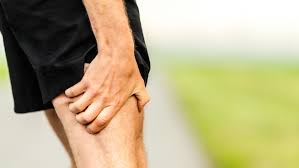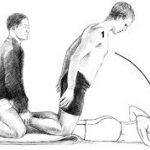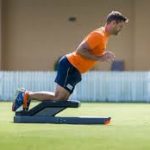I have strained my hamstrings, when can I return to playing football?

Article Written by Manas Moholkar
Hamstring strains are one of the most common injuries in Australian Rules Football that contribute to players missing games at all levels. Colac Physiotherapist, Manas Moholkar, discusses how long it will take for you to recover from a hamstring strain.
One of the main reasons for this being a common injury is the nature of the sport. As we are are all aware the shape of the Australian football is Oval, thus it leads to the ball changing directions in an unpredictable manner. Hence, on various occasions through a game or training session, the player has to accelerate, decelerate and change directions depending on the way the football behaves. It is very essential for a footballer to have eccentric strength (lengthening of the muscle as it contracts) in his hamstrings to play this sport which requires acceleration and deceleration in a predictable and an unpredictable manner. Thus if a footballer lacks the necessary strength in his hamstrings or if there’s an imbalance of strength between the left and right side a footballer is more prone to hamstring injuries.
Apart from the above mechanism, a footballer can also strain his hamstring if he lacks enough flexibility in the muscle and ends up straining it in a stretched position.
What is the role of the hamstring?
Most of us consider the hamstring as one muscle, but the fact is, it’s a group of 3 different muscles which are called the hamstrings. They are: Semimembranosus, Semitendinosus, Biceps Femoris (short and long head).
The hamstring is a complex muscle as it works over 2 joints. It is responsible for flexing your knee (bending it backwards) and extending your hip (backward movement of our leg from the hip joint). It is essential for generating the forces we need to run fast as it acts as a brake to stop our knee hyperextending at one end and drives our leg through with our gluts to propel us along. As it has to assist in controlling 2 joints and 2 different functions if forces are added that are unexpected our hamstrings can be vulnerable especially if they are not strong enough.
Types of Hamstring injuries:
- Type I– When a footballer injures his hamstring while running or sprinting or decelerating it’s called a type I strain.
- Type II– When a footballer strains his hamstring when his hamstrings are in a stretched position, it called as a type II strain, for e.g. Lunging forward to tackle someone whilst running or bending forward while picking up a football off the ground while running or in motion.
Grades of Hamstring strains:
- Grade I– It is also called as a mild strain. There’s a partial tear of muscle fibre. In some cases it might be overstretching of a muscle without a tear. Its likely a footballer may continue playing and experience symptoms after the game.
- Grade II– Partial tear in the muscle with difficulty walking. A footballer ends up discontinuing the game.
- Grade III– Total rupture of muscle. A footballer has difficulty walking of the field. Its likely he might end up having a large bruise by next day. While over the next few days, he might have a lump over the strained muscle.
How does a Physiotherapist determine a time frame for returning to football?
When physios assess a strained hamstring, we often consider the following aspects before giving a time frame on returning to sport:
Type of strain vs Grade of strain is the first thing we try to understand when a footballer presents his injury to us. We then find out, whether he has injured this hamstring for the first time or is it a recurrence of previously injured hamstring. If it’s a recurrence then, we discuss about frequency of recurrence and last recurrence. Pre-season strength of hamstrings is considered (strength of hamstring can be measured on a piece of equipment we have at the clinic called the Norbord, which will be discussed later in the article. It is also important to know, whether at pre-season there was major discrepancy in strength of the affect hamstring vs unaffected hamstring.
Once we know the above details, we take it in consideration the following prognostic factors.
Number of days required for the footballer to walk without pain following injury, if the footballer has taken more than 1 day to walk without pain, then it’s very likely he might need more than 3 weeks to return to full sports (Brukner & Khan 2016).
Location Of Injury According to Brukner & Khan (2016), if the injury is closer to pelvis, then the recovery period is going to be greater as compared to injury closer to knee joint. Amount of tenderness exhibited on assessment following the injury, Tenderness is directly proportional to slower return to sports.
Confidence Although confidence is a very subjective thing and requires a thorough understanding between physio and footballer, it plays an important role in decision making on whether the footballer is fit to return to sports. If the player is lacking confidence in their hamstring then they are not ready.
Thus, at the point of assessment, we consider all the factors mentioned above, before giving a timeframe on return to sports.
What do I need to do in order to return to sports?
It’s normal for a footballer to think that he needs to get back to sports as soon as possible as there’s a pressure on him to play for his team and make a difference. Many times, he also feels a pressure due to expectations from his coaching staff to make himself available as soon as possible. Although it’s very essential for a footballer and support staff to understand if a hamstrings strain is not treated and rehabilitated its very likely their footballer will strain it again. This premature return to sport might lead to more absence as compared to returning back with full rehab and confidence.
A full rehab includes, soft tissue therapy and exercises prescribed by a physiotherapist depending on the extent of injury. The player must be able to regain full stretch without play and be able to contract the muscle pain free before stepping up to doing higher level activities such as jogging, striding and sprinting. The transition then is to guide a player through drills and skills such as taking off and decelerating, bending down to pick up a low ball and doing some competitive drills that show that the player has confidence in all aspects of the sport. A player has to go at a submaximal intensity until they have no pain or soreness either during or after a session.
Along side this players need to be doing some targeted strengthening to strengthen the muscle using what we call eccentric exercises. These exercises involve the muscle contracting as it lengthens. These are really tough exercises but essential to have strong hamstrings.
While at the end of the rehabilitation, it’s can be really helpful to get an objective measure of his hamstring strength. We have a tool to measure the strength of hamstrings, which called as a Nordbord. According to AFL football protocols, it’s essential for a footballer to have 300N strength in his hamstrings to return back to sport. While it’s also important that both hamstrings i.e. injured and uninjured hamstrings have equal or nearly equal strength in order to return to sport and minimise the risk of recurrence of injury.
To see a video of the Nordbord in action click on these links
References:
- B & Brukner. P (2016), “Clinical sports Medicine” Vol.1, Edition 5th
- Opar, D.A, Williams M.D, Timmins, R.G, Hickey.Jack, Duhig, S.J, and Shield. A (2015), ‘’Eccentric Hamstring strength and Hamstring injury risk in Australian Footballers’’ School of Sciences, Australian Catholic University, Melbourne, Australia.



